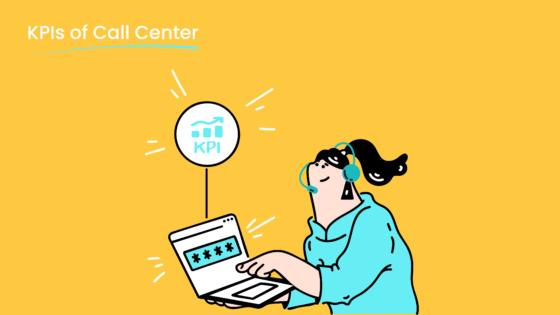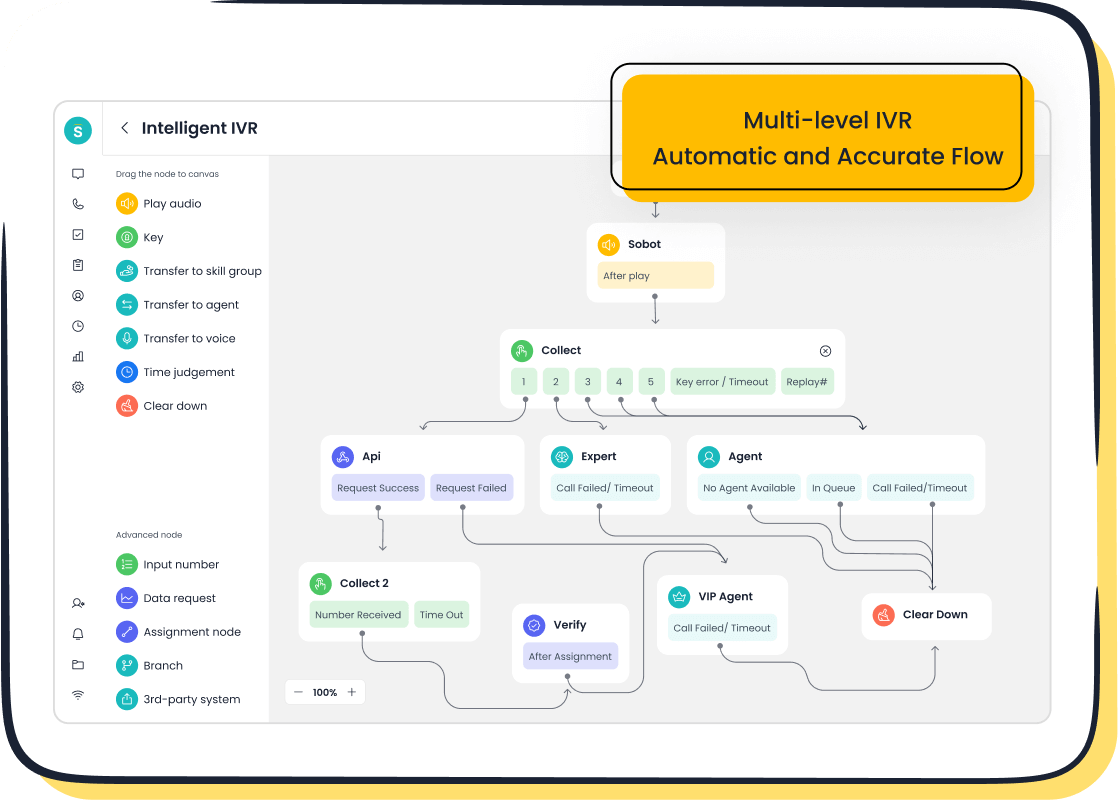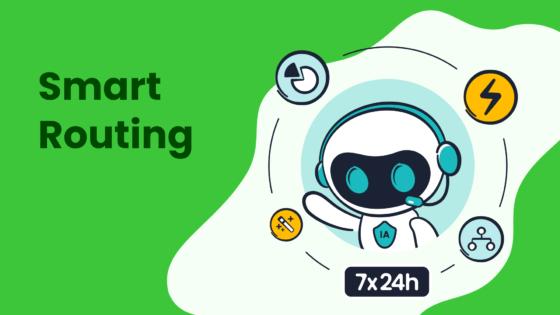Call Center KPIs That Drive Performance Improvement

Key performance indicators for a call center provide a roadmap for tracking and improving results. They help you identify gaps and implement solutions that directly impact customer satisfaction and operational efficiency. Metrics like Customer Satisfaction Score (CSAT) and First Call Resolution (FCR) highlight areas where you can enhance service quality. For example, a higher FCR not only builds customer trust but also reduces costs. By aligning these KPIs with your business objectives, you can achieve effective performance measurement and make data-driven decisions. Tools like Sobot's solutions further simplify this process, offering actionable tips to boost efficiency and outcomes.
Understanding Key Performance Indicators for a Call Center
What Are Call Center KPIs and Why Do They Matter?
Call center KPIs are measurable metrics that help you evaluate the performance of your call center operations. These indicators provide insights into how well your team meets customer expectations and achieves business objectives. By tracking KPIs, you can identify areas for improvement, enhance service quality, and boost operational efficiency. For example, metrics like first call resolution and customer satisfaction score directly reflect how effectively your agents address customer needs.
KPIs also serve as a guide for aligning your call center's performance with broader business goals. They help you focus on what matters most—delivering exceptional service while optimizing resources. When you monitor these metrics consistently, you can make data-driven decisions that improve both customer satisfaction and your bottom line.
Commonly Used Call Center KPIs
First Call Resolution (FCR)
First call resolution measures the percentage of customer issues resolved during the first interaction. A high FCR rate indicates that your agents are well-trained and equipped to handle inquiries efficiently. This metric not only improves customer satisfaction but also reduces repeat calls, saving time and resources.
Customer Satisfaction Score (CSAT)
The customer satisfaction score gauges how happy customers are with the service they receive. It’s typically measured through post-interaction surveys. A high CSAT score reflects excellent service quality and fosters customer loyalty.
Net Promoter Score (NPS)
Net promoter score assesses customer loyalty by asking how likely they are to recommend your service. A high NPS indicates strong customer trust and satisfaction, which can lead to increased referrals and long-term growth.
Average Handle Time (AHT)
Average handle time tracks the average duration of a call, including hold and wrap-up time. While shorter AHT can improve efficiency, it’s essential to balance speed with quality to ensure customer needs are fully addressed.
Service Level and Response Time
Service level measures the percentage of calls answered within a specific time frame, while response time tracks how quickly agents respond to customer inquiries. Both metrics are critical for maintaining a positive customer experience.
Call Abandonment Rate
Call abandonment rate reflects the percentage of customers who hang up before speaking to an agent. A high rate often signals long wait times or inadequate staffing, which can frustrate customers and harm your reputation.
Agent Utilization Rate
Agent utilization rate measures the percentage of time agents spend on live calls compared to their total available time. This KPI helps you assess productivity and ensure your team is effectively managing their workload.

Pro Tip: Use tools like Sobot’s Voice/Call Center to monitor these KPIs in real time. Features like intelligent IVR and AI-powered analytics can help you improve metrics like FCR and AHT while maintaining high service levels.
How to Align KPIs with Business Goals
Aligning KPIs with your business goals ensures that your call center contributes to your organization’s overall success. Start by identifying your key objectives, such as improving customer satisfaction or reducing operational costs. Then, select KPIs that directly support these goals. For instance, if your priority is enhancing customer experience, focus on metrics like CSAT, NPS, and FCR. Regularly review your KPIs to ensure they remain relevant as your business evolves.
| Metric | Description |
|---|---|
| First Contact Resolution | Tracks the number of times an agent successfully handles the customer's issue at the first attempt. It is crucial for customer satisfaction. |
| Customer Satisfaction (CSAT) | Measures how satisfied customers are with services, indicating loyalty and potential long-term revenue. |
| Average Handling Time (AHT) | Measures the time an agent spends on a single interaction, impacting call wait times and retention rates. |
| Customer Effort Score (CES) | Indicates how easy it is for customers to resolve their issues, affecting overall customer experience. |
| Net Promoter Score (NPS) | Gauges customer loyalty based on their likelihood to recommend the service or agent. |
| Agent Utilization Rate | Measures the time agents spend on live calls, reflecting their productivity and efficiency. |
| Repeat Call Rate | Indicates how often issues are not resolved on the first call, highlighting areas for improvement. |
By aligning KPIs with your goals, you can create a focused strategy that drives measurable improvements in service quality and efficiency.
Strategies to Improve Call Center KPIs
Enhancing FCR Through Training and Sobot's Voice/Call Center Features
Improving first call resolution (FCR) begins with equipping your agents with the right skills and tools. Ongoing training and support play a critical role in ensuring agents can handle a wide range of customer inquiries effectively. Focus on teaching problem-solving techniques, product knowledge, and communication skills. For example, role-playing exercises can simulate real-life scenarios, helping agents practice resolving issues during the first interaction.

Technology also enhances FCR. Sobot's Voice/Call Center offers features like intelligent IVR and smart call routing, which direct customers to the most qualified agents. This reduces the chances of transfers and ensures faster resolution. Additionally, the platform’s AI-powered voicebot assists with common queries, freeing agents to focus on more complex issues. By combining training with advanced tools, you can achieve higher FCR rates, improving both customer satisfaction and operational efficiency.
Boosting Customer Satisfaction Score with Personalized Interactions
Personalized interactions make customers feel valued, which directly impacts their satisfaction. Train your agents to ask insightful questions and offer tailored recommendations. For instance, if a customer frequently purchases a specific product, suggesting complementary items can enhance their experience. Data analysis helps identify customer preferences and behaviors, enabling agents to deliver more relevant solutions.
Sobot’s unified workspace consolidates customer data across channels, giving agents a complete view of past interactions. This allows them to provide consistent and personalized service. Customer segmentation further refines communication strategies, ensuring your approach resonates with different groups. Analytics from call center tools reveal key drivers of satisfaction, helping you replicate successful strategies across your operations. By focusing on personalization, you can significantly boost your customer satisfaction scores.
Improving NPS by Addressing Customer Feedback
Net Promoter Score (NPS) reflects customer loyalty and their likelihood to recommend your service. Addressing customer feedback is one of the most effective strategies for improving this metric. Start by collecting feedback through surveys or sentiment analysis tools. Identify recurring themes, such as long wait times or unresolved issues, and prioritize them based on urgency and impact.
Sobot’s real-time analytics help you track NPS trends and evaluate the effectiveness of your initiatives. For example, if you implement a new training program and see an increase in NPS, it indicates the program is working. Conversely, a decline signals the need for further investigation. By understanding what works and addressing areas of dissatisfaction, you can create a better customer experience and foster long-term loyalty.
Pro Tip: Use sentiment analysis to categorize feedback and uncover specific reasons for dissatisfaction. This enables targeted improvements that have the greatest impact on your NPS.
Reducing AHT with AI-Powered Tools and Automation
Reducing average handle time (AHT) is essential for improving call center efficiency and delivering better service. AI-powered tools and automation can significantly streamline processes, enabling agents to resolve customer issues faster. For instance, AI-driven voicebots can handle repetitive queries, allowing agents to focus on more complex problems. Automation tools also assist with tasks like call routing and data entry, reducing the time spent on administrative work.

Sobot's Voice/Call Center offers advanced features like AI-powered voicebots and intelligent IVR systems. These tools ensure that customers are directed to the right agent or provided with instant solutions. Additionally, real-time analytics help identify bottlenecks in workflows, enabling you to implement targeted strategies for improvement.
| Company | Results |
|---|---|
| Rogers Communications | 7% shorter calls, 3% more customers stick around |
| Western Europe Telecom | 4% more issues fixed on first try, 4-point bump in customer loyalty |
| Capital One | 50% shorter calls, 15% happier customers |
| eBay | 20% better first-contact resolution, 10% happier customers |
These examples highlight how AI and automation can transform call center performance. By adopting such tools, you can reduce AHT while maintaining high service quality.
Optimizing Service Levels Using Workforce Management
Workforce management systems play a crucial role in maintaining optimal service levels. These tools help you match staffing levels with call volumes, ensuring that agents are neither overworked nor underutilized. Proper scheduling prevents long wait times, which can frustrate customers and harm your reputation.

Sobot's workforce management solutions integrate seamlessly with its Voice/Call Center platform. Features like real-time monitoring and predictive analytics allow you to forecast call volumes accurately. This ensures that you have the right number of agents available at all times.
| Evidence Type | Description |
|---|---|
| Optimized Operational Efficiency | Workforce management tools help match staffing levels to call volumes, reducing overstaffing costs. |
| Maintaining Service Levels | Ensures appropriate staffing according to demand, enhancing service delivery. |
| Boost Customer Experience | Adequate staffing with skilled agents leads to quicker resolution of customer issues, improving satisfaction rates. |
| Improved Employee Satisfaction | Proper scheduling prevents burnout, leading to higher retention and job satisfaction among agents. |
By leveraging workforce management systems, you can enhance both agent productivity and customer experience. This approach not only improves service delivery but also boosts overall performance.
Lowering Call Abandonment Rates with Queue Management Solutions
High call abandonment rates can negatively impact customer satisfaction and revenue. Queue management solutions help address this issue by reducing wait times and improving the overall service experience. Advanced call routing and optimized agent scheduling ensure that customers are connected to the right agent quickly.
Sobot's intelligent call routing system minimizes wait times by directing calls based on agent availability and expertise. The platform also provides real-time data on queue lengths, enabling you to make adjustments as needed.
- ExpertCallers improved customer satisfaction from 50% to 93% for PrinterPro.
- Call abandonment rate reduced to 8% through advanced call routing and optimized agent scheduling.
- Enhanced training programs for agents focused on technical skills and customer empathy.
According to a survey by American Express, each abandoned call costs businesses approximately $50, leading to potential daily losses of around $4,000 in sales. Reducing the average queue time to under two minutes can significantly decrease the abandoned call rate and potentially increase revenue by $3,000 per day. Implementing queue management solutions ensures a smoother customer journey and better service outcomes.
Increasing Agent Utilization Through Effective Scheduling
Effective scheduling plays a vital role in increasing agent utilization rates. When you align staffing levels with customer demand, agents spend more time actively assisting customers and less time idle. This approach ensures that your team operates efficiently while maintaining high service quality.
Why Scheduling Matters for Agent Utilization
Scheduling impacts both agent productivity and customer satisfaction. Poor scheduling leads to overstaffing, which wastes resources, or understaffing, which causes delays and frustration. By implementing strategies that match agent availability with call volume patterns, you can optimize performance and enhance the customer experience.
Tip: Use scheduling tools that analyze historical call data to predict peak times. This helps you allocate resources effectively and avoid bottlenecks.
Benefits of Effective Scheduling
- Higher Employee Retention: A well-planned schedule fosters a supportive work environment. Employees feel valued when their schedules accommodate their needs, reducing turnover and improving productivity. In fact, 79% of employees consider their schedules when deciding whether to stay with an employer.
- Improved Productivity: Responsible scheduling practices, like those used in The Gap's retail experiment, resulted in a 5.1% increase in staff productivity and a 3.3% boost in sales.
- Operational Efficiency: Aligning staffing with demand minimizes idle time and ensures agents focus on customer interactions. This directly impacts utilization rates and overall performance.
Strategies for Effective Scheduling
-
Analyze Call Volume Trends
Use historical data to identify peak and off-peak hours. Schedule more agents during busy periods and fewer during slower times. This ensures optimal coverage without overstaffing. -
Leverage Workforce Management Tools
Workforce management systems simplify scheduling by automating resource allocation. Tools like Sobot’s Voice/Call Center integrate real-time analytics to forecast demand and adjust schedules dynamically. -
Offer Flexible Scheduling Options
Provide agents with flexible shifts to accommodate their preferences. This improves morale and reduces absenteeism, leading to higher productivity. -
Monitor and Adjust Regularly
Continuously track agent utilization rates and adjust schedules as needed. Real-time monitoring tools help you identify inefficiencies and implement corrective measures quickly.
Data Supporting Effective Scheduling
| Evidence Type | Description |
|---|---|
| Employee Retention | 79% of employees consider their schedules in staying with an employer, reducing attrition. |
| Productivity Increase | The Gap's retail experiment showed a 5.1% increase in staff productivity and a 3.3% increase in sales. |
| Operational Efficiency | Efficient scheduling aligns staffing with demand, minimizing idle time and maximizing productivity. |
By adopting these strategies, you can create a balanced schedule that maximizes agent utilization while maintaining service quality. This approach not only improves operational efficiency but also enhances the overall customer experience.
Leveraging Technology to Track and Analyze Call Center KPIs

The Role of Sobot's Voice/Call Center in KPI Monitoring
Sobot's Voice/Call Center provides a robust platform for monitoring call center KPIs in real time. Its intelligent features, such as smart call routing and AI-powered voicebots, ensure that you can track key metrics like first call resolution and average handle time with precision. The platform's unified workspace consolidates all customer interactions, enabling you to analyze data from multiple channels in one place. This comprehensive view helps you identify trends and areas for improvement.
The system's real-time monitoring capabilities allow you to address issues as they arise. For example, if call abandonment rates spike, you can quickly adjust staffing levels or optimize queue management. Additionally, Sobot's integration with CRM systems ensures seamless data flow, making it easier to align your call center's performance with broader business goals. By leveraging Sobot's tools, you can enhance service delivery and operational efficiency.
Benefits of Real-Time Analytics and Dashboards
Real-time analytics and dashboards transform how you manage call center operations. These tools provide instant insights into your team's performance, helping you make informed decisions quickly. With real-time data, you can uncover bottlenecks that hinder sales processes and pinpoint areas where agents need additional training. This proactive approach improves both service quality and operational efficiency.
Dashboards also foster a culture of accountability and motivation. By tracking progress against set targets, you can encourage healthy competition among agents. Gamification elements, such as leaderboards, make performance tracking engaging and rewarding. Additionally, real-time analytics help you focus on the most promising leads, maximizing your team's impact.
Key benefits of real-time analytics and dashboards include:
- Uncovering bottlenecks hindering sales processes
- Pinpointing specific areas for enhancing agent performance
- Tracking progress against set targets and goals
- Fostering healthy competition among agents through gamification
- Directing efforts toward the most promising leads for maximum impact
Sobot's Voice/Call Center integrates these features seamlessly, offering customizable dashboards that align with your unique business needs. This ensures you stay ahead in delivering exceptional service.
Using AI and Automation for Performance Insights
AI and automation have revolutionized how call centers analyze KPIs. These technologies enable real-time analysis of vast amounts of data, allowing you to adapt quickly to trends and customer needs. For instance, AI-generated performance reports provide detailed insights into engagement metrics, helping you offer personalized feedback to agents. This improves their effectiveness and boosts overall service quality.
AI also uncovers hidden patterns in KPIs, offering actionable insights that enhance customer service and operational efficiency. Predictive capabilities help you foresee potential issues, enabling you to address them before they escalate. Automation reduces manual effort and eliminates human error in data interpretation, ensuring accurate and reliable insights.
Some key advantages of integrating AI and automation include:
- Real-time analysis of large datasets for quick adaptation
- Detailed performance reports for personalized agent feedback
- Identification of hidden patterns in KPIs for actionable insights
- Predictive capabilities to foresee and mitigate potential issues
- Reduced manual effort and human error in data interpretation
Sobot's Voice/Call Center leverages AI to deliver these benefits. Its AI-powered voicebots and intelligent IVR systems streamline operations, allowing you to focus on strategic improvements. By adopting these technologies, you can achieve better performance outcomes and elevate your customer service standards.
Integrating CRM Systems for Enhanced Data Analysis
Customer Relationship Management (CRM) systems play a vital role in improving data analysis for call centers. By integrating a CRM system with your call center operations, you can centralize customer information, streamline workflows, and gain actionable insights. This integration allows you to make data-driven decisions that enhance both customer satisfaction and operational efficiency.
Benefits of CRM Integration in Call Centers
-
Centralized Customer Data
A CRM system consolidates customer information into a single platform. This includes interaction history, purchase behavior, and preferences. When agents access this data during calls, they can provide personalized service. For example, if a customer frequently contacts your support team about a specific product, the CRM system highlights this trend. This enables agents to address the issue more effectively. -
Enhanced Reporting and Analytics
CRM systems offer advanced reporting tools that analyze call center KPIs like First Call Resolution (FCR) and Customer Satisfaction Score (CSAT). These insights help you identify trends and areas for improvement. For instance, if your CRM data shows a high call abandonment rate during peak hours, you can adjust staffing levels to reduce wait times. -
Improved Collaboration Across Teams
Integrating a CRM system fosters better collaboration between your sales, marketing, and support teams. Shared access to customer data ensures everyone works toward the same goals. For example, your marketing team can use CRM insights to create targeted campaigns, while your support team focuses on resolving customer issues.
How Sobot Enhances CRM Integration

Sobot's Voice/Call Center seamlessly integrates with popular CRM systems like Salesforce and HubSpot. This integration ensures that your agents have real-time access to customer data, enabling them to deliver exceptional service. Sobot's unified workspace consolidates all interactions, making it easier to track and analyze customer behavior. Additionally, the platform's AI-powered tools provide predictive insights, helping you anticipate customer needs and improve service quality.
Pro Tip: Use Sobot's real-time analytics to monitor key metrics like Net Promoter Score (NPS) and Average Handle Time (AHT). These insights help you optimize your call center operations and achieve better results.
Real-World Example: Samsung's Success with CRM Integration
Samsung, a global leader in technology, achieved a 97% customer satisfaction rate by integrating Sobot's all-in-one contact center solution with its internal CRM system. This integration allowed Samsung to unify communication channels and provide agents with comprehensive customer data. As a result, Samsung improved agent efficiency by 30% and delivered a seamless customer experience. Learn more about Samsung's success story here.
Key Takeaways
| Benefit | Description |
|---|---|
| Centralized Data | Combines customer information into one platform for better accessibility. |
| Advanced Analytics | Provides insights into KPIs like FCR and CSAT for data-driven decisions. |
| Improved Team Collaboration | Ensures sales, marketing, and support teams work cohesively. |
Integrating CRM systems with your call center operations is no longer optional—it's essential. By leveraging tools like Sobot's Voice/Call Center, you can unlock the full potential of your data, improve customer satisfaction, and drive business growth.
Continuous Improvement Through KPI Reviews
Conducting Regular KPI Audits
Regular KPI audits ensure your call center stays on track to meet its goals. By reviewing metrics consistently, you can identify trends, address issues, and maintain high service quality. Establishing a routine for these audits is essential. For example, scheduling weekly or monthly evaluations ensures timely feedback and helps you stay proactive.
Analyzing data trends during audits reveals patterns in performance. For instance, a decline in first call resolution may indicate the need for additional agent training. Engaging your team in feedback sessions during these audits also uncovers valuable insights. Agents often provide firsthand observations that highlight areas needing improvement. This collaborative approach strengthens your service delivery and fosters a culture of continuous improvement.
Tip: Use tools like Sobot’s Voice/Call Center to streamline KPI audits. Its real-time analytics make it easier to monitor trends and take corrective action promptly.
Setting Realistic and Achievable KPI Targets
Setting realistic KPI targets ensures your team remains motivated and focused. Start by analyzing past performance data to identify achievable benchmarks. Researching industry standards also helps you set competitive goals. For example, if the average call abandonment rate in your industry is 8%, aim to match or exceed this standard.
Involving stakeholders in the target-setting process ensures alignment with organizational priorities. Use the SMART framework—Specific, Measurable, Attainable, Relevant, Time-bound—to define your KPIs. Regularly monitoring these targets allows you to adjust them as needed, ensuring they remain relevant and achievable.
| Step | Description |
|---|---|
| 1 | Analyze past performance data to identify trends. |
| 2 | Research industry benchmarks to set competitive standards. |
| 3 | Involve stakeholders to ensure KPIs reflect organizational priorities. |
| 4 | Ensure KPIs are SMART (Specific, Measurable, Attainable, Relevant, Time-bound). |
| 5 | Regularly monitor and evaluate KPIs for continuous improvement. |
Adapting Strategies Based on KPI Trends
Adapting your strategies based on KPI trends ensures your call center remains agile and effective. Real-time data provides immediate insights into call center activity, enabling quick adjustments. For example, if you notice a spike in call abandonment rates, you can reallocate agents to high-demand periods to minimize customer frustration.
Historical trends offer a broader context for performance analysis. These trends help you identify recurring issues and develop long-term strategies. Drill-down functionality in analytics tools allows you to investigate specific metrics, such as average handle time, to pinpoint areas needing improvement. AI tools further enhance this process by analyzing large datasets and providing actionable insights. For instance, targeted training based on AI recommendations can improve agent skills and boost customer satisfaction.
| Evidence Type | Description |
|---|---|
| Real-time Data | Provides immediate insights into call center activity, enabling quick adjustments to staffing and call routing to minimize customer frustration. |
| Historical Trends | Offers a broader context for performance analysis, helping identify patterns for long-term strategy adjustments. |
| Drill-down Functionality | Allows managers to investigate specific metrics in detail, facilitating targeted interventions for performance improvement. |
Pro Tip: Leverage Sobot’s AI-powered tools to analyze KPI trends and implement targeted strategies. This approach enhances both operational efficiency and service quality.
Encouraging Feedback Loops for Ongoing Optimization
Feedback loops are essential for improving your call center's performance. They create a continuous cycle of learning and adaptation, helping you refine processes and meet customer expectations. By actively gathering feedback from both customers and employees, you can uncover valuable insights that drive meaningful changes.
Start by observing your contact center data regularly. This helps you measure the impact of any adjustments on customer satisfaction. For example, tracking metrics like First Call Resolution (FCR) or Average Handle Time (AHT) reveals how well your team addresses customer needs. Establishing clear KPIs ensures you can assess the effectiveness of your feedback loops and identify areas needing improvement.
Encourage open dialogue by soliciting feedback from your team and customers. Employees often have firsthand knowledge of operational challenges, while customers provide insights into their experiences. Tools like Insight7, Zendesk, and CallMiner simplify the process of collecting and analyzing this feedback. These platforms help you identify trends and implement targeted solutions, enhancing overall performance.
Once you gather feedback, act on it promptly. For instance, if customers mention long wait times, consider optimizing your queue management system. Similarly, if employees highlight training gaps, provide additional resources to address these needs. Regularly reviewing and refining your strategies ensures your call center remains agile and customer-focused.
Feedback loops not only improve operational efficiency but also foster trust among your team and customers. When people see their input leads to positive changes, they feel valued. This strengthens relationships and contributes to long-term success.
Tip: Use real-time analytics to monitor the results of implemented changes. This ensures your feedback loops remain effective and aligned with your goals.
The Role of Employee Engagement in Achieving KPI Success

Impact of Agent Morale on Call Center KPIs
Agent morale directly influences call center performance. When call center agents feel valued and supported, they deliver higher-quality service and achieve better results. Studies show that 68% of business leaders believe employee enablement drives business growth. However, call centers often face high turnover rates, averaging between 30% and 45%, which negatively impacts morale and KPIs like customer satisfaction and first-call resolution.
A supportive company culture can counteract these challenges. Transparent performance metrics help agents understand their contributions, fostering accountability and motivation. For example, when agents see their impact on customer satisfaction scores, they feel a sense of accomplishment. Addressing burnout, which affects 76% of call center practitioners, is also critical. Tools like Sobot’s Voice/Call Center provide real-time analytics that highlight workload imbalances, enabling managers to make adjustments that improve morale and productivity.
| Insight | Description |
|---|---|
| High Turnover | Call centers experience high turnover rates, averaging between 30% and 45%. |
| Company Culture | A supportive culture enhances morale and reduces turnover. |
| Performance Transparency | KPIs provide clarity, fostering accountability and motivation. |
Providing Training and Development Opportunities
Training is essential for improving agent performance management and service delivery. Well-trained call center agents communicate more effectively, resolve issues faster, and achieve higher customer satisfaction. For instance, training programs that focus on first-call resolution empower agents to handle inquiries efficiently, reducing average handle time without compromising quality.
To maximize training outcomes, follow these steps:
- Define coaching objectives to align with organizational goals.
- Develop comprehensive training modules tailored to agent needs.
- Set SMART goals to measure progress.
- Monitor performance using analytics tools like Sobot’s Voice/Call Center.
- Provide regular feedback to reinforce learning and improvement.
When agents feel equipped to succeed, they experience a positive feedback loop. Resolving issues in one call boosts their confidence and motivation, which enhances overall service quality. Sobot’s unified workspace simplifies training by consolidating customer data, enabling agents to deliver personalized solutions effectively.
Recognizing and Rewarding High Performers
Recognition programs significantly improve call center KPIs. Rewarding high-performing agents motivates them to maintain excellence and inspires others to strive for better results. Research shows that reward programs can lead to a 22% performance gain, with long-term programs achieving up to 48% improvement for team-based rewards.
Effective recognition strategies include:
- Offering monetary incentives for achieving key metrics like customer satisfaction or first-call resolution.
- Creating leaderboards to celebrate top performers publicly.
- Providing non-monetary rewards, such as additional training opportunities or flexible schedules.
Firms with robust incentive programs experience 31% lower voluntary turnover, which directly impacts agent morale and service quality. Sobot’s analytics tools help identify high performers, ensuring recognition aligns with measurable achievements. By fostering a culture of appreciation, you can drive sustained improvements in call center performance.
Creating a Positive Work Environment to Reduce Turnover
A positive work environment plays a critical role in reducing employee turnover. When employees feel valued and supported, they are more likely to stay and perform at their best. You can create such an environment by focusing on well-being, engagement, and growth opportunities.
Start by fostering a supportive workplace that prioritizes work-life balance. Employees who feel overwhelmed or burned out often leave their roles. Addressing these issues improves their well-being and boosts their performance. For example, offering flexible schedules or mental health resources shows that you care about their needs.
Compensation and career advancement also contribute to retention. Employees who see clear paths for growth feel more motivated and engaged. You can outline individual development plans during training sessions to help them achieve their goals. This approach not only enhances their skills but also aligns their efforts with your business objectives.
Company culture sets the tone for employee satisfaction. A strong culture promotes empowerment and collaboration, making employees feel like valued members of the team. Regular feedback loops further strengthen this connection. When employees know their voices are heard, they feel more invested in their roles. You can use tools like Sobot’s Voice/Call Center to gather feedback and monitor team dynamics.
Proactive measures, such as recognizing achievements and providing ongoing training, reinforce a culture of growth. These efforts improve service quality and customer satisfaction while reducing turnover. By creating a workplace where employees thrive, you build a foundation for long-term success.
Tip: Encourage open communication and celebrate small wins to maintain a positive atmosphere. These simple actions can make a big difference in employee morale.
Tracking and improving call center KPIs is essential for enhancing service quality and operational efficiency. Metrics like Customer Satisfaction Score (CSAT), Net Promoter Score (NPS), and First Contact Resolution (FCR) provide actionable insights into customer experience and agent performance. Regular KPI reviews foster accountability, optimize resource allocation, and align your team with customer expectations. For example, monitoring trends in Average Handle Time (AHT) or call abandonment rates helps you identify inefficiencies and refine strategies.
Sobot's Voice/Call Center simplifies this process with real-time analytics, AI-powered tools, and seamless CRM integration. These features enable you to track KPIs effectively, improve service delivery, and achieve measurable results. By implementing the strategies discussed, you can create a customer-centric culture, boost satisfaction, and drive long-term success.
Pro Tip: Use KPI data to benchmark your performance against industry standards and continuously improve your service.
FAQ
What are the most important KPIs for a call center?
The most critical KPIs include First Call Resolution (FCR), Customer Satisfaction Score (CSAT), Net Promoter Score (NPS), Average Handle Time (AHT), and Call Abandonment Rate. These metrics help you measure customer experience, agent performance, and operational efficiency.
How can Sobot's Voice/Call Center improve my KPIs?
Sobot's Voice/Call Center offers tools like intelligent IVR, AI-powered voicebots, and real-time analytics. These features help you reduce AHT, improve FCR, and enhance CSAT by streamlining workflows and providing actionable insights.
Tip: Use Sobot's smart call routing to connect customers with the right agents faster.
How often should I review my call center KPIs?
You should review KPIs weekly or monthly. Regular reviews help you identify trends, address issues, and adjust strategies promptly. Consistent monitoring ensures your call center stays aligned with business goals and customer expectations.
What is the best way to reduce call abandonment rates?
Implement queue management solutions like Sobot's intelligent call routing. These tools minimize wait times by directing calls to available agents. You can also use real-time monitoring to adjust staffing levels during peak hours.
Can AI really improve call center performance?
Yes, AI enhances performance by automating repetitive tasks, analyzing large datasets, and providing actionable insights. Tools like Sobot's AI-powered voicebots handle common queries, allowing agents to focus on complex issues. This improves efficiency and customer satisfaction.
Pro Tip: Leverage AI to predict call volume trends and optimize resource allocation.
See Also
Essential Strategies for Effective Call Center Quality Management
Enhancing Call Center Efficiency Through Effective Monitoring Techniques
Best Call Center Analytics Tools You Need in 2024
Key Features to Look for in CRM Call Center Software
Comprehensive Guide to Quality Management Systems in Call Centers
